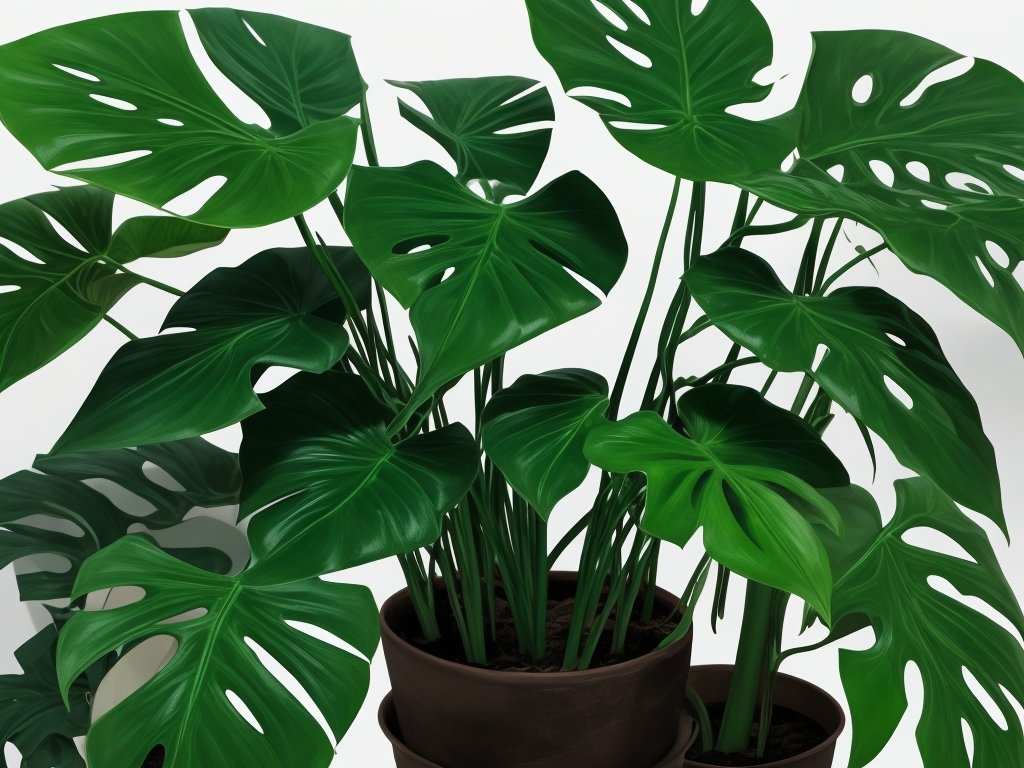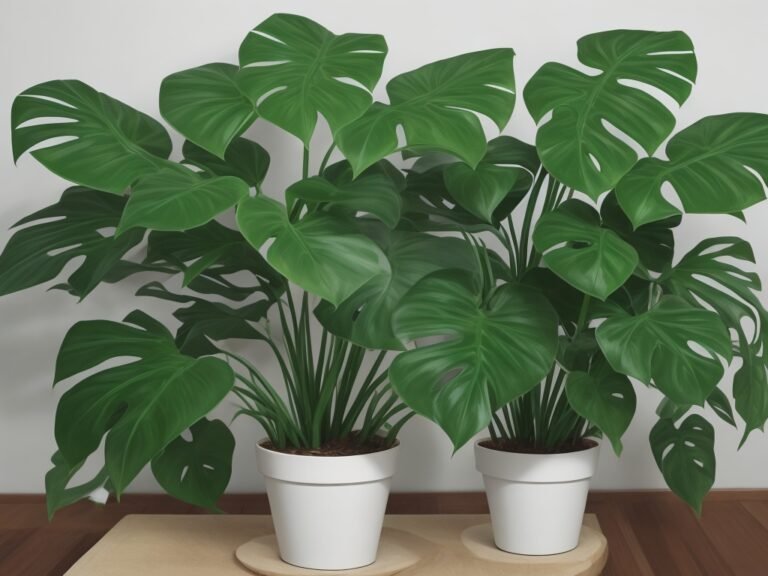How Often Should You Fertilize a Monstera Plant?
Key Takeaways:
- Fertilize your Monstera plant once a month during its active growing season.
- Use a balanced, water-soluble fertilizer for optimal growth and health.
- Adjust fertilization frequency based on the size and age of your Monstera plant.
- Avoid over-fertilizing, as it can cause nutrient burn and harm the plant.
Are you a Monstera plant parent?
If you are, then you probably already know how stunning and mesmerizing these leafy giants can be.
But to keep your Monstera thriving and lush, proper care is essential.
And when it comes to fertilizing, it’s crucial to strike the right balance.
Too little, and your plant may not reach its full potential.
Too much, and you risk damaging its delicate roots.
In this article, I’ll guide you through the ins and outs of fertilizing a Monstera plant, including the factors to consider, frequency guidelines, and signs of over- or under-fertilization.
Get ready to nourish your green companion and witness its astonishing growth!
| Fertilization Schedule | Notes |
|---|---|
| Once every 2 weeks | During the growing season (spring and summer) |
| Once a month | During the dormant season (fall and winter) |
| Every 6 months | If slow-release fertilizer is used |
Understanding the Monstera Plant
The Monstera plant is a popular houseplant known for its unique leaf shape and easy-care nature.
Understanding its characteristics and care requirements is key to keeping it healthy and thriving.
Characteristics and care requirements of Monstera plants
The Monstera plant, also known as the Swiss cheese plant, is known for its large, glossy leaves and unique holey appearance. It is a tropical plant that thrives in warm, humid environments.
Here are some care requirements for Monstera plants:
- Light: Monstera plants prefer bright, indirect light. Avoid placing them in direct sunlight, as it can scorch the leaves.
- Watering: Keep the soil evenly moist, but be careful not to overwater. Allow the top inch of soil to dry out before watering again.
- Humidity: Monstera plants appreciate high humidity levels. Increase humidity by misting the leaves, placing the plant on a tray filled with water and pebbles, or using a humidifier.
- Temperature: Ideally, Monstera plants thrive in temperatures between 65-85°F (18-29°C. Avoid exposing them to drafts or sudden temperature changes.
- Soil: Use well-draining soil rich in organic matter. A mix of peat moss, perlite, and potting soil works well for Monstera plants.
- Fertilizer: Feed your Monstera plant regularly during the growing season (spring and summer with a balanced, water-soluble fertilizer. Follow the instructions on the fertilizer package for proper dosage.
- Pruning: Prune your Monstera plant to control its size and shape. Remove dead or yellowing leaves, and trim excessively long stems to encourage bushier growth.
Remember, every Monstera plant is unique, so it’s important to observe your plant and adjust its care as needed. With the right conditions and care, your Monstera plant will thrive and become a beautiful addition to your indoor space.
Importance of Fertilizing Monstera Plants
Fertilizing Monstera plants is important for their overall health and growth.
It provides essential nutrients and promotes lush foliage.
Why is fertilizing essential for Monstera plants?
Fertilizing is essential for Monstera plants because it provides them with the necessary nutrients to grow and thrive.
It promotes healthy foliage, encourages robust root development, and improves overall plant vigor.
Without proper fertilization, Monstera plants may become weak, have stunted growth, or show signs of nutrient deficiencies.
Regular fertilizing ensures that the plants have the essential nutrients they need for optimal health and vitality.

Benefits of fertilizing Monstera plants
Fertilizing Monstera plants provides a range of benefits. It promotes healthy growth, encourages lush foliage, and enhances overall plant vitality.
Fertilizers supply essential nutrients that may be lacking in the soil, ensuring the plant receives everything it needs to thrive.
It also helps Monstera plants produce more leaves, resulting in a fuller and more attractive appearance.

Factors to Consider for Fertilization Frequency
When determining how often to fertilize your Monstera plant, there are several factors to consider.
These include the growth stage of the plant, environmental factors, and the type of fertilizer you are using.
Growth stage of the Monstera plant
The growth stage of the Monstera plant refers to the period when the plant is actively growing and developing new leaves and roots.
This is an important stage for the plant’s overall health and vitality.
During this stage, it is crucial to provide proper nutrition and care to support healthy growth.
Environmental factors affecting fertilization frequency
The environmental factors that affect fertilization frequency for Monstera plants include light, temperature, humidity, and soil conditions.
Adequate sunlight is crucial for photosynthesis and nutrient uptake.
Temperature and humidity should be within the plant’s preferred range to support growth and nutrient absorption.
Proper soil conditions, such as well-draining and nutrient-rich soil, allow for optimal nutrient uptake.
Regular assessment and adjustment of these factors can help determine the frequency of fertilization for your Monstera plant.

Type of fertilizer and its release rate
There are various types of fertilizers that you can use for your Monstera plant, such as balanced fertilizers, organic fertilizers, and slow-release fertilizers.
The choice of fertilizer depends on your preference and the specific needs of your plant.
As for the release rate, slow-release fertilizers release nutrients gradually over an extended period, providing a steady supply of nutrients to the plant.
It’s a convenient option that requires less frequent application compared to traditional fertilizers.

Fertilizing Frequency Guidelines for Monstera Plants
When it comes to fertilizing Monstera plants, there are some guidelines to keep in mind.
Let’s explore the frequency during the growing season, in the winter or dormant season, and a step-by-step guide for fertilizing.
Frequency during the growing season
During the growing season, you should fertilize your Monstera plant every 2-4 weeks.
This regular feeding helps provide essential nutrients for healthy growth.
Be sure to follow the instructions on your fertilizer package for the correct dosage and dilution.
Frequency in winter or dormant season
During the winter or dormant season, you should reduce the frequency of fertilizing your Monstera plant.
Since the plant’s growth slows down during this time, it requires less nutrients.
Fertilize your Monstera plant once every 6-8 weeks or when you observe signs of new growth to ensure proper nourishment without overfeeding.
Step-by-step guide for fertilizing Monstera plants
To fertilize your Monstera plant, start by selecting a balanced fertilizer specifically formulated for houseplants.
Dilute the fertilizer according to the package instructions.
Water the plant thoroughly before applying the fertilizer to avoid root burn.
Apply the diluted fertilizer directly to the soil, making sure to cover the entire root zone.
Avoid getting fertilizer on the leaves to prevent damage.
Repeat this process every 2-4 weeks during the growing season.
In winter or during the plant’s dormant period, reduce fertilization to every 6-8 weeks.
Regularly monitor the plant for signs of over or under-fertilization and adjust accordingly.
Signs of Over-Fertilization or Under-Fertilization
Here are the signs of over-fertilization or under-fertilization for your Monstera plant.
Symptoms of over-fertilization in Monstera plants
Over-fertilization in Monstera plants can cause a range of symptoms, including leaf burn, yellowing or browning of leaves, wilting, stunted growth, and root damage. The excessive nutrients can disrupt the plant’s natural balance and lead to these visible signs.
It’s important to monitor your plant’s response to fertilization and adjust accordingly to prevent over-fertilization.
Symptoms of under-fertilization in Monstera plants
Symptoms of under-fertilization in Monstera plants include slow growth, pale or yellowing leaves, and weak stems. The plant may also produce smaller and fewer leaves, and its overall appearance may look stunted or unhealthy.
Lack of nutrients can affect the plant’s ability to thrive and may lead to a weakened immune system, making it more susceptible to pests and diseases.
Other Tips for Healthy Growth and Maintenance
For healthy growth and maintenance of your Monstera plant, make sure to water it properly, provide adequate light, and learn how to prune and propagate it effectively.
Proper watering techniques for Monstera plants
To properly water a Monstera plant, it’s important to find the right balance. You’ll want to water it thoroughly, allowing the water to drain out of the bottom of the pot.
Make sure the top inch of soil is dry before watering again.
Avoid over-watering or letting the plant sit in water for too long. Regularly check the soil moisture to ensure you’re watering correctly.
Light requirements for Monstera plants
Monstera plants thrive in bright, indirect light.
They can tolerate some direct sunlight, but too much can scorch their leaves.
Place them near a north or east-facing window for optimal light exposure.
If your Monstera isn’t getting enough light, it may become leggy or have smaller leaves.
Pruning and propagation tips for Monstera plants
To keep your Monstera plant healthy and encourage new growth, pruning is important. Trim away any yellow or brown leaves, damaged stems, or overgrown sections.
You can also propagate your Monstera by taking stem cuttings and placing them in water or in well-draining soil.
Make sure to provide the right conditions for propagation, including indirect sunlight and moist soil. With proper pruning and propagation, your Monstera plant will thrive and grow beautifully.
Frequently Asked Questions
Can I use organic fertilizers for Monstera plants?
Yes, you can definitely use organic fertilizers for your Monstera plants. Organic fertilizers, such as compost, compost tea, or fish emulsion, provide natural nutrients and promote healthy growth.
They are a great option for those who prefer a more sustainable and eco-friendly approach to plant care.
Just make sure to follow the instructions on the packaging and apply the organic fertilizer according to the recommended frequency for optimal results.
Can I over-fertilize my Monstera plant?
Yes, you can over-fertilize your Monstera plant. Over-fertilization can lead to nutrient burn, where the excessive amount of nutrients damages the plant’s roots and leaves.
It’s important to follow the recommended guidelines for fertilization to avoid harming your Monstera.
What are some alternative ways to nourish Monstera plants without fertilizers?
To nourish Monstera plants without fertilizers, you can try these alternative methods:
- Use compost: Incorporate organic compost into the soil to provide natural nutrients.
- Mulch with organic matter: Apply a layer of mulch made from leaves, grass clippings, or shredded bark to enrich the soil over time.
- Vermicomposting: Start a worm composting bin and use the resulting nutrient-rich worm castings as a natural fertilizer.
- Use organic liquid fertilizers: Opt for organic liquid fertilizers made from seaweed, fish emulsion, or compost tea to feed your plants naturally.
- Collect rainwater: Water your Monstera plants with rainwater, which contains natural minerals that can nourish them.
Remember, these alternative methods may not provide the same instant boost as traditional fertilizers, but they can contribute to the long-term health and vitality of your Monstera plants.
Final Verdict
Fertilizing your Monstera plant is crucial for its overall health and growth.
Understanding the characteristics and care requirements of Monstera plants, as well as the importance and benefits of fertilization, will guide you in determining the frequency of fertilizing.
Factors such as the growth stage of the plant, environmental conditions, and the type of fertilizer used should be considered.
ensure the optimal health of your Monstera plantzation during the growing and dormant seasons, along with proper watering, lighting, pruning, and propagation techniques, will ensure the optimal health of your Monstera plant.
Avoiding common mistakes and seeking alternative ways to nourish your plant without over-fertilization is also important.
By maintaining a balanced fertilization schedule, you can help your Monstera plant thrive and enjoy its lush, vibrant leaves.







